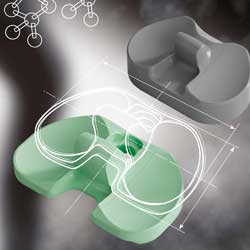Pity not the science-fiction protagonist, for he (or she) leads quite the coveted life. With an arsenal of mind-boggling technology at his disposal, the sci-fi hero’s world is a harmless, watered-down microcosm of manageable events—sans challenge, chaos and complication.
There are fixes for every conceivable threat to the human condition, from cancer, inebriation and insomnia to hunger, aging, even death. Ego-boosters such as physiognomic face-changing templates, designer eyes, false memory implants, and alternate realities are available as well.
Yet none of the elixirs are a match for the shape-shifting machine assassin featured in Philip K. Dick’s 1957 short story “The Unreconstructed M” (though a Crechepod full life-support device might have bought the victim some time). In the story, a machine the size of a Ritz cracker box breaks into an apartment and kills a man with an explosive pellet shot to the skull, then turns itself into a common household electronic to avoid detection.
“‘Get ready—he ought to still be here.’ Another voice, a man’s voice, like the first. The hall door was pushed open and two individuals in heavy overcoats sprinted purposefully into the apartment. At their approach, the machine dropped to the kitchen floor, the water glass forgotten. Something had gone wrong. Its rectangular outline flowed and wavered; pulling itself into an upright package, it fused its shape into that of a conventional TV unit.
“It was holding that emergency form when one of the men—tall, red-haired—peered briefly into the kitchen.
“‘Nobody in here,’ the man declared, and hurried on.”
Nobody human, anyway. The television set—in some respects—displays almost superhuman qualities, transmogrifying at will and possessing the acumen to both maintain its disguise and recognize faces (at one point in Dick’s dark tale, the television changes back into its original form and “hops” into its owner’s arms).
Eventually, investigators discover the shape-shifting machine is comprised of alien material harvested from a white dwarf star system.
That certainly would explain its transformational abilities.
Or would it?
In a classic case of life imitating art, Massachusetts Institute of Technology (MIT) researchers have developed a way to adjust the property and shape of materials over time when exposed to certain environmental changes. Dubbed “4-D printing” for the added dimension of time, the process takes existing additive manufacturing technology one step further by simply manipulating a substance’s geometric composition.
3-D printing creates objects layer by layer from a virtual blueprint. To enter the fourth dimension, though, product designers must feed the 3-D printer a precise geometric code based on the object’s own angles and dimensions as well as measurements that dictate its required shape when subjected to such outside forces as movement, moisture, pressure or temperature.
In short, the code sets the direction, the number of times and the angles at which a material can bend and curl. When that object is confronted with a change in environment, it can be stimulated to change shape. Pipes, for example, could be instructed to expand or shrink to move water; similarly, bricks could shift to accommodate more or less stress on a given wall; and car tires could be programmed to automatically adjust their grip on icy or rainy roads.
The technology potentially could revolutionize medicine, producing implantable devices that change their shape and function upon contact with particular cells or biochemical processes. Imagine custom-designed cardiac stents that naturally expand within narrowed or weakened arteries without help from surgeons. Or tiny electrodes that coil around nerves; self-coiling cochlear implants; and better-fitting neurovascular coils (used to pack aneurysm sacs to prevent them from rupturing).
“They [neurovascular coils] can be printed in a manner that allows for customized shape or material changes and can react to specific biological stimuli,” said Venkat Rajan, industry manager for medical devices at global growth consulting firm Frost & Sullivan. “4-D printing allows for additive manufacturing components that enable the printed object to adapt or react to its surroundings. In the case of a 4-D-printed medical implant, it could allow it to expand or self-construct in a manner that ensures greatest fit within the body. Also, there is the potential for it to react and adapt to changes in the body—in the same way our native tissue might.”
MIT researchers are a long way off from replicating human tissue. Thus far, they’ve only managed to 4-D print a stiff plastic that remained rigid and water-absorbent university initials that morphed into the letters “SAL.” Scientists also haven’t decoded the formula to material longevity: After several dozen wet-dry cycles, the water-absorbent substance loses its transformational capability.
Still, the technology could help the medtech industry finally match wits with the Great Mother. Since Egypt introduced the world to surgical sutures in 3000 B.C., mankind has searched for the perfect biological backup, experimenting with nearly every material on Earth, including lead, silver, bronze, Teflon, Dacron, nickel, stainless steel, Titanium, ceramics and plastics—all to no avail.
Nature historically has maintained the upper hand, and for good reason—it’s had an inimitable head start, refining its masterwork over millions of years to create a complex, self-organizing system encompassing dozens of cell types and intricate vasculatures designed to perform very specific jobs. Each system is unique, shaped by gender, genetics, living environments, habits and activity levels.
“[Human] tissue is very well organized, according to very stringent rules, in cellular sets,” explained Gabor Gorgacs, a University of Missouri biological physicist and co-founder of 3-D printed tissue developer Organovo Holdings Inc. of San Diego, Calif. “A half-millimeter aggregate is already a little piece of tissue. Those pieces bind together and exchange information. The cells know what to do because they’ve been doing this for millions of years. They learned the rules of the game during evolution.”
Humans are proving to be apt pupils, though. Over the last several decades, scientists have tweaked the formulas for existing materials to improve their performance within the body. Wayne State University (Detroit, Mich.) researchers, for example, created a stronger, lighter, more durable type of steel by combining bainitic steel and austempered ductile iron. Its fine-scale microstructure of ferrite and carbon stabilized austenite gives the new compound nearly three times the fracture toughness of advanced steels currently on the market.
Ceramics experts are enhancing neuromodulation technology with piezocomposite components (lead zirconate titanate and single-crystal piezo materials) that facilitate ultrasonic device communication, ceramic-to-metal brazed assemblies for hermetically sealed electrical feedthroughs, and biocompatible device casings. Researchers also are exploring the use of ceramic injection molding to develop thin-walled cases for implantable pulse generators (most are made of titanium).
Morgan Technical Ceramics, a division of United Kingdom-based Morgan Crucible Company plc, is developing implantable housing for migraine and cluster headache treatment using Zirconia injection molding. Revered for its high mechanical strength, Zirconia enables implantable pulse generator casings to be manufactured with very thin walls and eliminates the need for these outdoor tv antennas feedthrough wires; the ceramic casing is brazed and hermetically bonded to the feedthrough.
Such innovations, however, still pale in comparison to the strides made in medical polymers. With their comparatively light weight, low cost, flexibility, ease of processing, non-ferrous properties (e.g., MRI safe) and superior biocompatibility, medical plastics have become an integral medtech component, enabling the next generation of implants, single-use devices and packaging technology, among others. In fact, global demand for medical polymers reached nearly 5 million tons in 2013, and is expected to exceed 7 million tons by 2020, according to market data.
“Prior to plastics being used extensively in the design of medical devices, metals were the predominate materials. Although metals offered some inherent advantages for these applications, particularly regarding strength properties, they also demonstrated inherent liabilities, such as susceptibility to corrosion,” noted Bing J. Carbone, president of Shelton, Conn.-based Modern Plastics Inc., a plastics distributor to the medical industry. “When plastics were first being introduced widely to the medical device industry, the attractions included ease of manufacture, the ability to custom compound, flexibility, corrosion resistance, and of course, the ability to produce grades that would be acceptable to FDA standards. Over the years, as the field has matured, there are many more options today regarding what plastics may be selected for use, and where they can be obtained. Almost every day someone, somewhere is looking at the viability of replacing a legacy metal device with plastic, or designing a new offering with plastic as opposed to metal.”
Those new offerings run the gamut from antibacterials and electrode coatings to medical connectors (rigid polyvinyl chloride), and wearable medical devices.
Bayer MaterialScience is targeting the $2.5 billion wearable devices market with its moldable, dimensionally stable polycarbonate combo, Makroblend M525. The material, company executives claim, is compatible with thin-wall molding and long flow paths, and achieves good adhesion using standard assembly methods like welding and adhesive bonding. It also can be color matched to satisfy wearable devices’ multi-hued design requirements.
Teknor Apex, on the other hand, is gaining recognition for its alternative to polycarbonate medical connectors, which generally are prone to stress cracking upon contact with flexible polyvinyl chloride (PVC) parts. The company’s rigid PVC reportedly can replace polycarbonate in clear medical components such as connectors and check valves, achieving comparable strength and clarity while reducing or eliminating stress cracking. Extensive testing revealed the Apex SCR rigid PVC grades resisted stress cracking seven to 17 days longer than traditional polycarbonate.
“Apex SCR compounds provide a way for the industry to address the [stress cracking] problem in many applications without having to compromise end-use performance,” said Peter Galland, industry manager of Teknor Apex’s Vinyl Division. “Stress cracking is a problem the medical device industry has had to deal with for decades.”
It’s not the only problem, though. Bacteria have shadowed the industry since its birth, claiming millions of victims and costing healthcare systems worldwide countless numbers of dollars. Researchers consequently are retaliating with antibacterial polymers designed to resist or inhibit the growth of harmful microbes.
Rotterdam, Netherlands-based Parx Plastics BV has dispatched its biocompatible Sanipolymers in the war against germs. The material, according to the company, does not leach or degrade, and can reduce bacteria by 99 percent over the product’s lifetime. Potential applications include surgical meshes, hospital interiors, device casings, wound dressings, surgery aprons, IV lines, dialysis machines—practically anything that carries an infection risk.
Future reinforcements are likely to come from the Wyss Institute for Biologically Inspired Engineering in Cambridge, Mass.; A*STAR (Agency for Science, Technology and Research) in Singapore; Nanyang Technological University (also in Singapore) and City University of Hong Kong, China. The Wyss researchers have developed polymers that can store considerable amounts of lubricating liquids within their molecular structure and release them over time to render the material slippery, and thus, repellant to bacteria.
The Asian scientists, meanwhile, are perfecting a material that both repels bacteria and attracts healthy cells to implants. Their thin-film coating is still at the proof-of-concept stage and therefore, won’t clinically be available for years, but initial tests are promising. The film base is made from polyelectrolyte (dextran sulfate and chitosan) multilayers, and attached to a number of specific bonding molecules called ligands. After testing various concentrations of different ligands, analysts found that the RGD peptide (Arginylglycylaspartic acid) was best at preventing the attachment of bacterial cells and encouraging the assemblage of healthy cells.
“Plastics are unique design materials in that because of the ability to reconfigure the structure of most plastics more so than any other material, the modifications to fit a specific purpose are almost unlimited,” Carbone told Medical Product Outsourcing.
Particularly in the orthopedic industry, where polymers increasingly are being used to enhance implant radiolucency, bone growth or bioresorbability. Secant Medical Inc. is pursuing the bioresorbable angle with its Regenerez technology, designed to promote healing without the chronic inflammation associated with other bioresorbable materials.
Company executives contend that poly glycerol sebacate (PGS) has equivalent or better performance compared with traditional resorbables like polyglycolic acid (PGA) and polylactic acid (PLA), both of which lose strength as they degrade, potentially causing product failure. The pair also can trigger inflammation and scarring.
Conversely, the natural metabolites of PGS (glycerol and sebacic acid) act as the nutrients to the wound space, allowing the formation of a more natural extracellular matrix that does not negatively impact the healing process. It also resorbs within 60 days.
“PGS can promote healing, without an acute inflammatory response, and the native tissue results with minimal scar tissue,” said Emily Ho, director and general manager, Advanced Biomaterials & Contract Device Services for Perkasie, Pa.-based
Secant, a developer of biomaterials and biomedical textile structures. The company is a business unit of Fenner PLC, a maker of reinforced polymer engineering headquartered in Yorkshire, England.
“As a surface-eroding material, its degradation characteristics are more predictable than bulk eroders such as PGA and PLA, and there is more control over the loss of mechanical properties,” Ho continued. “Regenerez closely simulates the modulus of human tissue, thereby limiting the compliance mismatch issues seen with other materials.”
Although it’s been used extensively in academic research—cited in more than 400 in vivo and in-vitro cardiovascular, orthopedic, neurovascular and general surgery studies—regulatory hurdles and the typical jitters associated with new material introductions has stalled the commercialization of PGS.
New silicone materials have fallen victim to regulatory requirements as well, particularly in the wake of the 2010 breast implant scandal triggered by French firm Poly Implant Prothèse. The company triggered a global panic after admitting to using industrial-grade silicone in thousands of breast implants sold worldwide. Roughly 300,000 women in 65 countries are believed to have received the faulty implants.
“As the result of breast implant litigation in the early 1990s, increased regulation was applied to silicone and long-term implantable products manufactured from it,” explained Norman L. Riley, technical marketing director for Applied Silicone Corporation, a global supplier of implantable silicone material for the critical healthcare and medical device markets. “In response to that increased regulation, silicone manufacturers were forced to re-evaluate the material biocompatibility and look at smaller details like extractables—making sure they were identifiable, quantifiable and predictable. Another round of scrutiny and increased regulation was initiated by notified bodies in Europe during the 2011-2012 silicone breast implants recall in France, which resulted in tighter specifications for silicones that are closer to those implemented by the FDA (U.S. Food and Drug Administration).”
Such crackdowns often limit innovation to new applications for existing materials. Applied Silicone, for instance, introduced a high-strength, responsive silicone gel last fall for the implantable device market. The Dual Matrix Gel System, according to the company, incorporates a unique crosslink technology to improve fracture resistance, cohesive strength and adhesion.
So the quest continues.
Countless centuries on, mankind still is searching for nature’s magic bullet—the secret recipe of biological building blocks that comprise a near-perfect mechanism of muscle, tissue, bones and cells. He’s scoured the planet for alternatives to the body’s defective parts and come up with some of his own (i.e., polymers, ceramic composites, bioresorbables), often looking to the Great Mother for hints. And each time, the grande dame has refused to reveal her hand.
Maybe it’s time to change strategies. Rather than trying to copy nature, perhaps man should look for (or create) a material that can live harmoniously within the body’s harsh, complex environment. Modern Plastics’ Carbone believes we’ve already found such a substance: “As we are learning more about the body, genetics, and how our bodies can interact with our immediate environment, we are learning more and more about how plastics can work with, and be part of, the natural body, to become a hybrid capable of accomplishing more than a standalone ever could.”
– See more at: https://www.mpo-mag.com/contents/view_features/2015-03-11/polymer-principles#sthash.rIZHWV7L.dpuf











Such an amazing article you got here. This is a great tip! I need to try this one.